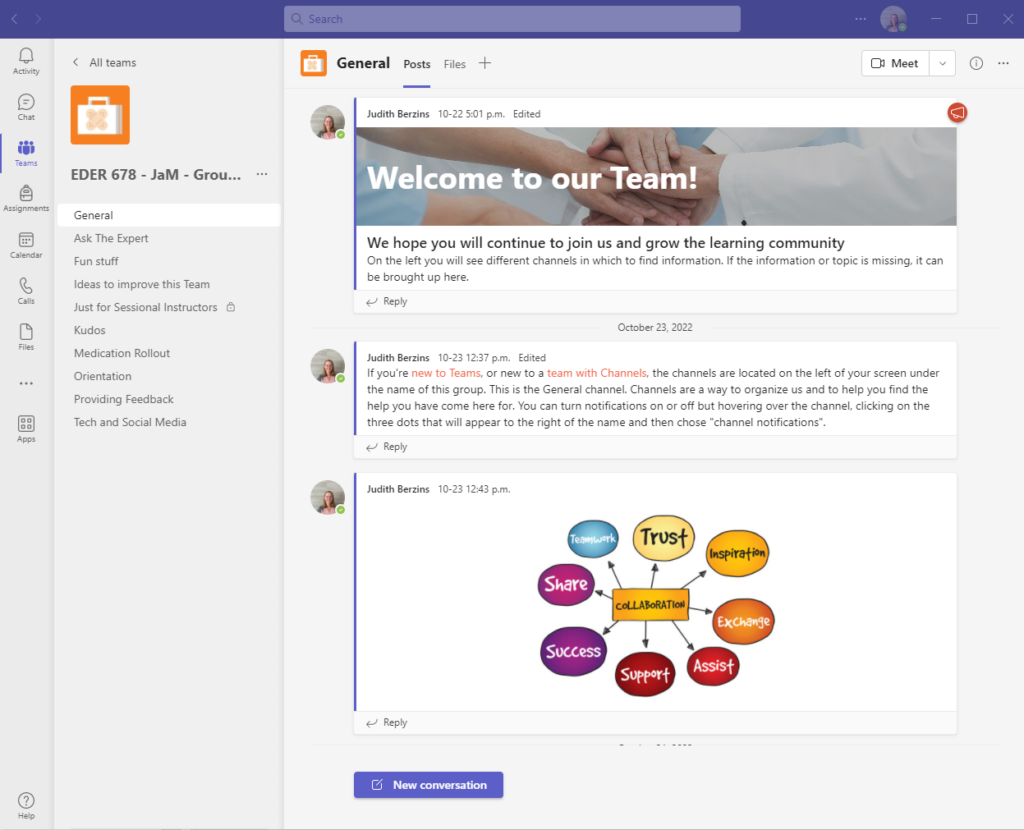
Teams is our best option for a central location for our training activities and a place to encourage collaboration and community. We want to encourage a sense of belonging and a space for instructors to share their knowledge and collaboratively problem-solve any issue they may have with regards to teaching clinical instruction.
The Faculty of Nursing at the University of Calgary is struggling to recruit and retain qualified sessional nursing instructors for the clinical instruction portion of the program, which is a key part of student learning. This activity was developed to help nursing instructors feel a sense of belonging and to find the professional development resources that they desire to be successful and return year after year to instruct future nurses. Building on the theory of Social Constructivism and that “This social process cannot effectively be replaced by technology, although technology may facilitate it” (Bates, 2022). We will facilitate interactions between sessional instructors to construct knowledge from the vast and varying amount of experience each nurse possesses.
For a quick tutorial on the basics of using Teams, watch this video:
For this activity, we set up a team in MS Teams that will help Nursing Sessional Instructors to connect, form a community, and learn from each other. They can learn both strategies to improve their nursing instruction and how to use tech to their advantage. Our goal is to develop the Team into a robust sharing and educational tool. There will be channels that will filter the content, make it searchable, and you can create subgroups by limiting access to each channel. It is also a space where our instructors can meet virtually, which is one more way for them to share knowledge.
The University of Calgary Nursing program has several satellite locations, and as well, Calgary-based instructors teach at several locations within the city and on campus. MS teams is available on mobile devices and traditional computers, making it accessible from all sites. Regardless of their physical location, this is a way for new instructors to connect with each other, more experienced nurses and support staff, and find the help that they need. It does not matter where an instructor is located, they can access Teams easily. As well, it is already a part of the UCalgary ecosystem, it is not new to many UCalgary instructors, and it is approved by the University for many purposes. Teams supports links to Instagram, the web, Twitter, YouTube, can be used to share and store docs, presentations, videos and more. Any way that our instructors want to create or find content, they can also share it through MS Teams.
This activity could be moved from this platform in the future, if the need is there to engage and connect instructors from other institutions or make this an open resource. Presently, it is specifically for the use of UCalgary sessional nursing instructor and it fits all of the requirements, rules and regulations of the institution. An added benefit to MS Teams is that the other three activities can be linked within Teams and it neatly keeps all four of our activities under one digital roof.
If you would like to be added to this Team to check it out, contact Jude: judith.berzins@ucalgary.ca
Supporting Literature
Morrison (2020) writes that Nursing instructors may have clinical expertise but need support of teaching skills. They need to feel valued and connected. There is no one-size-fits all approach as each faculty and each instructor have different requirements. One thing that was fairly common was the need for support from the faculty and their peers. This is a safe space for instructors to reach out for the help they need, as well as a repository for resources to aid sessional instructors.
When instructors feel supported and connected to their faculty, they tend to stay longer. Demonstrating that there is a vibrant community of support would be a benefit for recruiting new instructors. As far back as we can trace human history, we have had a desire to form communities (Brumfiel, 2022). It is an innate desire to belong, and it leads to successful outcomes. Morrison (2020) identifies belonging to a community to be one of the criteria that will retain part-time nursing instructors.
Scardamalia and Bereiter (2014) also write about the benefits of connection and community to encourage learning. During the pandemic our traditional ways of building community were challenged. This time period highlighted how we can use different tech tools to build communities. As Belshaw (2014) says “… the Civic element is about using digital environments to self-organise”. This will give the instructors agency to improve their clinical teaching skills, learn from and support each other, and build the community they need for success.
References
Bates, A.W. (2022) Teaching in a Digital Age: Guidelines for designing teaching and learning. 3rd edition. Retrieved from https://pressbooks.bccampus.ca/teachinginadigitalagev3m/
Belshaw, D. (2014). The Essential Elements of Digital Literacies. Retrieved from: http://digitalliteraci.es
Brumfiel, G. (2022). Genetic sequencing gives us the first-ever look at Neanderthal clan. NPR.org. Retrieved October 24, 2022 from https://www.npr.org/2022/10/20/1130170913/neanderthal-clan-family-genetic-sequencing?utm_campaign=npr&utm_medium=social&utm_source=facebook.com&utm_term=nprnews&fbclid=IwAR0s8X8m1tZpHxFzv3rBJxEN9EKOa6Gf2AOI8704TOH4tBLCYjNm7mkNnl8
Morrison, L. (2020). Assessing Part-Time Nursing Faculty Needs: A Needs Assessment for a Quality Improvement Project. Teaching and Learning in Nursing, 15(1), 42–44. https://doi.org/10.1016/j.teln.2019.08.011
Scardamalia, M., & Bereiter, C. (2014). Knowledge Building and Knowledge Creation: Theory, Pedagogy, and Technology. In R. Sawyer (Ed.), The Cambridge Handbook of the Learning Sciences (Cambridge Handbooks in Psychology, pp. 397-417). Cambridge: Cambridge University Press. https://doi:10.1017/CBO9781139519526.025